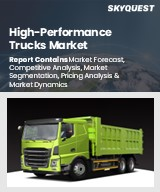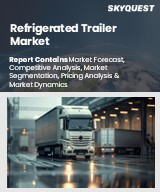
|
시장보고서
상품코드
1524232
세계의 클래스 1 트럭 시장 규모 : 연료별, 용도별, 제품별 - 예측(2024-2032년)Class 1 Truck Market Size - By Fuel (Diesel, Gasoline, Hybrid, Electric), By Application (Personal, Commercial), By Product (Minivan, Cargo Van, SUV, Pickup Truck) & Forecast, 2024 - 2032 |
||||||
세계의 클래스 1 트럭 시장 규모는 도시화와 라스트마일 배송 수요의 증가에 의해 촉진되며, 2024-2032년에 CAGR 6% 초과를 기록할 것으로 생각됩니다.
유엔인구기금(UNFPA)에 따르면 현재 전 세계 인구의 절반 이상이 도시와 마을에 거주하고 있으며, 이 수치는 2030년까지 약 50억 명으로 늘어날 것으로 예상됩니다.
더 많은 사람들이 도시로 이주함에 따라 소비자의 집 앞까지 직접 상품을 효율적으로 배송해야 할 필요성이 커지고 있습니다. 클래스 1 트럭은 컴팩트한 크기와 기동성으로 유명하며, 도시 환경과 혼잡한 도로를 이동하는 데 이상적입니다. 이 트럭은 증가하는 E-Commerce 주문에 신속하고 안정적으로 대응할 수 있게 해줍니다. 또한 신속하고 유연한 배송 서비스에 대한 중요성이 강조되면서 이러한 트럭에 대한 수요가 증가하여 인구 밀집 지역의 물류 및 운송 수요 증가를 지원하고 있습니다.
상업 부문은 진화하는 물류 요구와 운영 효율성으로 인해 2024-2032년 사이 두드러진 CAGR을 나타낼 것으로 예상됩니다. 이 트럭은 도시 환경에서 범용성을 제공하며, 기동성과 컴팩트한 크기는 혼잡한 도로를 이동하고 효율적으로 물품을 배송하는 데 매우 중요합니다. 또한 기술 및 안전 장비의 발전으로 생산성과 운전자 편의성이 향상되어 차량 최적화를 원하는 기업에게 어필하고 있습니다. 또한 운영 비용 절감과 엄격한 배기가스 배출 기준 준수라는 경제적 이점으로 인해 1등급 트럭은 경쟁이 치열한 시장에서 다양한 상업용 용도에 선호되는 선택이 되고 있습니다.
휘발유 부문은 2032년까지 1등급 트럭 시장에서 주목할 만한 점유율을 차지할 것입니다. 가솔린 트럭은 대체 연료 옵션에 비해 초기 구매 비용이 저렴하여 효율적인 운송을 원하는 기업 및 개인 소비자에게 실용적인 솔루션을 제공합니다. 휘발유 주유 인프라가 널리 보급되어 있으며, 사용자의 편의성과 접근성이 보장됩니다. 또한 가솔린 엔진 기술의 발전으로 연비가 향상되고 배기가스 배출량이 감소하여 환경 규제와 청정 운송 솔루션에 대한 소비자의 선호에 부응하고 있습니다. 이러한 요소들이 종합적으로 가솔린 트럭 부문에서 1등급 트럭의 인기 상승에 기여하고 있습니다.
유럽의 1등급 트럭 시장은 큰 성장세를 보이고 있으며, 예측 기간 중 CAGR이 유망합니다. 엄격한 환경 규제와 도시 혼잡으로 인해 1등급 트럭과 같은 작고 연비가 좋은 차량으로의 전환이 가속화되고 있습니다. 이러한 차량은 좁은 도시 지역을 주행하고 배기 가스 규제를 준수하는 데 적합하므로 도시 물류 및 라스트 마일 배송 서비스에 이상적입니다. 또한 지속가능성과 탄소 배출량 감소에 대한 관심은 클래스 1 카테고리에서 전기자동차와 하이브리드 차량에 대한 선호도가 높아지는 추세와도 일치합니다. 이러한 추세는 유럽에서 보다 깨끗하고 효율적인 운송 솔루션을 향한 광범위한 움직임을 지원하고 있습니다.
목차
제1장 조사 방법과 조사 범위
제2장 개요
제3장 업계 인사이트
- 에코시스템 분석
- 공급업체 상황
- 원재료 공급업체
- 부품 공급업체
- 제조업체
- 서비스·프로바이더
- 유통 채널
- 최종사용자
- 이익률 분석
- 기술과 혁신 전망
- 특허 분석
- 주요 뉴스
- 규제 상황
- 영향요인
- 촉진요인
- 업계의 잠재적 리스크와 과제
- 성장 가능성 분석
- Porter의 산업 분석
- PESTEL 분석
제4장 경쟁 구도
- 서론
- 기업 점유율 분석
- 경쟁 포지셔닝 매트릭스
- 전략 전망 매트릭스
제5장 시장 추산·예측 : 연료별(2021-2032년)
- 주요 동향
- 디젤
- 미니밴
- 카고 밴
- SUV
- 픽업 트럭
- 가솔린
- 미니밴
- 카고 밴
- SUV
- 픽업 트럭
- 하이브리드
- 미니밴
- 카고 밴
- SUV
- 픽업 트럭
- 전기
- 미니밴
- 카고 밴
- SUV
- 픽업 트럭
- 기타
- 미니밴
- 카고 밴
- SUV
- 픽업 트럭
제6장 시장 추산·예측 : 제품별(2021-2032년)
- 주요 동향
- 미니밴
- 카고 밴
- SUV
- 픽업 트럭
제7장 시장 추산·예측 : 용도별(2021-2032년)
- 주요 동향
- 개인용
- 상업용
제8장 시장 추산·예측 : 지역별(2021-2032년)(
- 주요 동향
- 북미
- 미국
- 캐나다
- 유럽
- 영국
- 독일
- 프랑스
- 이탈리아
- 러시아
- 벨기에
- 스웨덴
- 기타 유럽
- 아시아태평양
- 중국
- 인도
- 일본
- 한국
- 인도네시아
- 태국
- 베트남
- 기타 아시아태평양
- 라틴아메리카
- 브라질
- 멕시코
- 아르헨티나
- 기타 라틴아메리카
- 중동 및 아프리카
- 남아프리카공화국
- 아랍에미리트
- 사우디아라비아
- 이란
- 터키
- 기타 중동 및 아프리카
제9장 기업 개요
- Ford Motor Company
- General Motors
- Stellantis(previously Fiat Chrysler Automobiles)
- Toyota Motor Corporation
- Nissan Motor Co.
- Honda Motor Co.
- Hyundai Motor Company
- Mercedes-Benz Group
- Volkswagen AG
- Renault SA
- Peugeot SA(part of Stellantis)
- Isuzu Motors Ltd.
- Mitsubishi Motors Corporation
- Mahindra & Mahindra Ltd.
- Tata Motors
Global Class 1 Truck Market will indicate over 6% CAGR from 2024 to 2032, driven by urbanization and the rise of last-mile delivery demand.
According to UNFPA, more than half of the worlds population currently resides in cities and towns, and this number is expected to rise to approximately 5 billion by 2030.
As more people move to cities, the need for efficient delivery of goods directly to consumers doorsteps intensifies. Class 1 trucks, known for their compact size and maneuverability, are ideal for navigating urban environments and congested streets. They enable businesses to fulfill the rising volume of e-commerce orders swiftly and reliably. Additionally, the growing emphasis on quick and flexible delivery services boosts the demand for these trucks, supporting the expanding logistics and transportation needs in densely populated areas.
The overall class 1 truck industry is classified based on fuel, application, product, and region.
The commercial segment will depict a remarkable CAGR during 2024-2032, owing to evolving logistical needs and operational efficiencies. These trucks offer versatility in urban environments, where maneuverability and compact size are crucial for navigating congested streets and delivering goods efficiently. Additionally, advancements in technology and safety features enhance productivity and driver comfort, appealing to businesses seeking to optimize their fleets. Moreover, the economic benefits of lower operational costs and compliance with stringent emissions standards thrust adoption, making Class 1 trucks a preferred choice for various commercial applications in the competitive marketplace.
The gasoline sector will seize a noteworthy class 1 truck market share by 2032. Gasoline-powered trucks offer a practical solution for businesses and individual consumers seeking efficient transportation with lower initial purchase costs compared to alternative fuel options. The availability of gasoline fueling infrastructure is widespread, ensuring convenience and accessibility for users. Moreover, advancements in gasoline engine technology have improved fuel efficiency and reduced emissions, aligning with environmental regulations and consumer preferences for cleaner transportation solutions. These factors collectively contribute to the growing popularity of Class 1 trucks in the gasoline segment.
Europe class 1 truck market will record significant growth, with a promising CAGR during the forecast period. Stringent environmental regulations and urban congestion have prompted a shift towards smaller, more fuel-efficient vehicles like Class 1 trucks. These vehicles are well-suited for navigating narrow city streets and complying with emissions standards, making them ideal for urban logistics and last-mile delivery services. Additionally, the emphasis on sustainability and reducing carbon footprints aligns with the growing preference for electric and hybrid options within the Class 1 category. These trends underscore a broader movement towards cleaner and more efficient transportation solutions in Europe.
Table of Contents
Chapter 1 Methodology & Scope
- 1.1 Research design
- 1.1.1 Research approach
- 1.1.2 Data collection methods
- 1.2 Base estimates and calculations
- 1.2.1 Base year calculation
- 1.2.2 Key trends for market estimates
- 1.3 Forecast model
- 1.4 Primary research & validation
- 1.4.1 Primary sources
- 1.4.2 Data mining sources
- 1.5 Market definitions
Chapter 2 Executive Summary
- 2.1 Industry 360° synopsis, 2021 - 2032
Chapter 3 Industry Insights
- 3.1 Industry ecosystem analysis
- 3.2 Supplier landscape
- 3.2.1 Raw material suppliers
- 3.2.2 Component suppliers
- 3.2.3 Manufacturers
- 3.2.4 Service providers
- 3.2.5 Distribution channel
- 3.2.6 End users
- 3.3 Profit margin analysis
- 3.4 Technology & innovation landscape
- 3.5 Patent analysis
- 3.6 Key news & initiatives
- 3.7 Regulatory landscape
- 3.8 Impact forces
- 3.8.1 Growth drivers
- 3.8.1.1 Rising trend towards outdoor recreation and adventure
- 3.8.1.2 Expanding gig economy and last-mile delivery services
- 3.8.1.3 Growing trend of home renovation and DIY projects among homeowners
- 3.8.1.4 Rapid urbanization and population growth in suburban areas
- 3.8.2 Industry pitfalls & challenges
- 3.8.2.1 Limited payload capacity and towing capability
- 3.8.1 Growth drivers
- 3.9 Growth potential analysis
- 3.10 Porter's analysis
- 3.11 PESTEL analysis
Chapter 4 Competitive Landscape, 2023
- 4.1 Introduction
- 4.2 Company market share analysis
- 4.3 Competitive positioning matrix
- 4.4 Strategic outlook matrix
Chapter 5 Market Estimates & Forecast, By Fuel, 2021 - 2032 ($Mn & Units)
- 5.1 Key trends
- 5.2 Diesel
- 5.2.1 Minivan
- 5.2.2 Cargo van
- 5.2.3 SUV
- 5.2.4 Pickup truck
- 5.3 Gasoline
- 5.3.1 Minivan
- 5.3.2 Cargo van
- 5.3.3 SUV
- 5.3.4 Pickup truck
- 5.4 Hybrid
- 5.4.1 Minivan
- 5.4.2 Cargo van
- 5.4.3 SUV
- 5.4.4 Pickup truck
- 5.5 Electric
- 5.5.1 Minivan
- 5.5.2 Cargo van
- 5.5.3 SUV
- 5.5.4 Pickup truck
- 5.6 Others
- 5.6.1 Minivan
- 5.6.2 Cargo van
- 5.6.3 SUV
- 5.6.4 Pickup truck
Chapter 6 Market Estimates & Forecast, By Product, 2021 - 2032 ($Mn & Units)
- 6.1 Key trends
- 6.2 Minivan
- 6.3 Cargo van
- 6.4 SUV
- 6.5 Pickup truck
Chapter 7 Market Estimates & Forecast, By Application, 2021 - 2032 ($Mn & Units)
- 7.1 Key trends
- 7.2 Personal
- 7.3 Commercial
Chapter 8 Market Estimates & Forecast, By Region, 2021 - 2032 (($Mn & Units)
- 8.1 Key trends
- 8.2 North America
- 8.2.1 U.S.
- 8.2.2 Canada
- 8.3 Europe
- 8.3.1 UK
- 8.3.2 Germany
- 8.3.3 France
- 8.3.4 Italy
- 8.3.5 Russia
- 8.3.6 Belgium
- 8.3.7 Sweden
- 8.3.8 Rest of Europe
- 8.4 Asia Pacific
- 8.4.1 China
- 8.4.2 India
- 8.4.3 Japan
- 8.4.4 South Korea
- 8.4.5 Indonesia
- 8.4.6 Thailand
- 8.4.7 Vietnam
- 8.4.8 Rest of Asia Pacific
- 8.5 Latin America
- 8.5.1 Brazil
- 8.5.2 Mexico
- 8.5.3 Argentina
- 8.5.4 Rest of Latin America
- 8.6 MEA
- 8.6.1 South Africa
- 8.6.2 UAE
- 8.6.3 Saudi Arabia
- 8.6.4 Iran
- 8.6.5 Turkey
- 8.6.6 Rest of MEA
Chapter 9 Company Profiles
- 9.1 Ford Motor Company
- 9.2 General Motors
- 9.3 Stellantis (previously Fiat Chrysler Automobiles)
- 9.4 Toyota Motor Corporation
- 9.5 Nissan Motor Co.
- 9.6 Honda Motor Co.
- 9.7 Hyundai Motor Company
- 9.8 Mercedes-Benz Group
- 9.9 Volkswagen AG
- 9.10 Renault SA
- 9.11 Peugeot SA (part of Stellantis)
- 9.12 Isuzu Motors Ltd.
- 9.13 Mitsubishi Motors Corporation
- 9.14 Mahindra & Mahindra Ltd.
- 9.15 Tata Motors



















